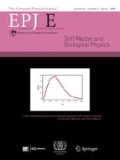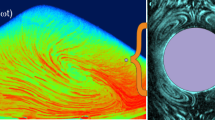Abstract
This paper investigates the particle scale dynamics of granular convection in vertically vibrated granular beds. The onset of the convection is found to coincide with the noticeable particle transverse migrations from the side walls towards the centre of the bed, which only take place in the wake of the gravity wave front dividing the upward moving particles and the falling ones. The mechanism driving the particle inward flows and thus sustaining the complete convection rolls can be understood in light of a convection model based on void penetration. This stochastic convection model reveals that the underlying driving force is a distinctive differential shear flow field arising from the combined effect of frictional holdback by the walls and the downward pull of gravity. The changes of the convection pattern with inceasing acceleration amplitude, in terms of the convection strength and the thickness of the bottom of the convection rolls, can be accounted for by this model.
Graphical abstract

Similar content being viewed by others
References
J. Matas, J. Uehara, R. Behringer, Eur. Phys. J. E 25, 431 (2008)
I.S. Aranson, L.S. Tsimring, Rev. Mod. Phys. 78, 641 (2006)
D.A. Huerta, J.C. Ruiz-Suárez, Phys. Rev. Lett. 92, 114301 (2004)
M. Rouijaa, C. Krülle, I. Rehberg, R. Grochowski, P. Walzel, Chem. Eng. Tech. 28, 41 (2005)
K.M. Aoki, T. Akiyama, K. Yamamoto, T. Yoshikawa, Europhys. Lett. 40, 159 (1997)
D.W. Wang, Y.C. Chou, T.M. Hong, Europhys. Lett. 35, 333 (1996)
J. Rajchenbach, Europhys. Lett. 16, 149 (1991)
S.-S. Hsiau, C.-C. Liao, P.-Y. Sheng, S.-C. Tai, Exp. Fluid. 51, 795 (2011)
C. Laroche, S. Douady, S. Fauve, J. Phys. (Paris) 50, 699 (1989)
S. Luding, E. Clément, A. Blumen, J. Rajchenbach, J. Duran, Phys. Rev. E 50, R1762 (1994)
H.K. Pak, E. Van Doorn, R.P. Behringer, Phys. Rev. Lett. 74, 4643 (1995)
E.v. Doorn, R.P. Behringer, Europhys. Lett. 40, 387 (1997)
J.B. Knight, Phys. Rev. E 55, 6016 (1997)
T. Shinbrot, D. Khakhar, J.J. McCarthy, J.M. Ottino, Phys. Rev. Lett. 79, 829 (1997)
Troy Shinbrot, D.V. Khakhar, J.J. McCarthy, J.M. Ottino, Phys. Rev. E 55, 6121 (1997)
T. Akiyama, K.M. Aoki, K. Yamamoto, T. Yoshikawa, Granular Matter 1, 15 (1998)
G.M. Rodríguez-Liñán, Y. Nahmad-Molinari, Phys. Rev. E 73, 011302 (2006)
S. Klongboonjit, C.S. Campbell, Phys. Fluids 20, 103303 (2008)
M. Majid, P. Walzel, Powder Tech. 192, 311 (2009)
R.D. Wildman, J.M. Huntley, D.J. Parker, Phys. Rev. Lett. 86, 3304 (2001)
J.M. Pastor, D. Maza, I. Zuriguel, A. Garcimartin, J.-F.Boudet, Physica D 232, 128 (2007)
D.C. Hong, S. Yue, Phys. Rev. E 58, 4763 (1998)
J.A.C. Gallas, H.J. Herrmann, S. Sokołowski, Phys. Stat. Mech. Appl. 189, 437 (1992)
L. Jysoo, J. Phys. A: Math. Gen. 27, L257 (1994)
T. Ohtsuki, T. Ohsawa, J. Phys. Soc. Jpn. 72, 1963 (2003)
M.Z. Bazant, Mech. Mater. 38, 717 (2004)
J. Choi, A. Kudrolli, R.R. Rosales, M.Z. Bazant, Phys. Rev. Lett. 92, 174301 (2004)
J.A. Perez, S.B. Kachuck, G.A. Voth, Phys. Rev. E 78, 041309 (2008)
J.B. Knight, E.E. Ehrichs, V.Y. Kuperman, J.K. Flint, H.M. Jaeger, S.R. Nagel, Phys. Rev. E 54, 5726 (1996)
R.D. Wildman, J.M. Huntley, D.J. Parker, Phys. Rev. E 63, 061311 (2001)
S.S. Hsiau, C.H. Chen, Powder Technol. 111, 210 (2000)
G.A. Voth, J.A. Perez, R. Son, in Powders and Grains 2009: Proceedings of the 6th International Conference on Micromechanics of Granular Media Golden (Colorado) 2009 (American Institute of Physics)
S. Douany, S. Fauve, C. Laroche, Europhys. Lett. 8, 621 (1989)
A. Ugawa, O. Sano, J. Phys. Soc. Jpn. 72, 1390 (2003)
V. Kamenetsky, A. Goldshtein, M. Shapiro, D. Degani, Phys. Fluids 12, 3036 (2000)
J. Bougie, S.J. Moon, J.B. Swift, H.L. Swinney, Phys. Rev. E 66, 051301 (2002)
If we consider more general particle/void packing configuration as shown in fig. 5(a) where neigboring voids in six directions rather than four directions as shown in fig. 5(c) are available to be filled, the ratio of the probability of the reference particle migrating rightward, $P_{\ab{above~right}}$ and $P_{\ab{below~right}}$ combined, and that of migrating leftward, $P_{\ab{above~left}}$ and $P_{\ab{below~left}}$ combined, remains the same as in the scenerio in fig. 5(c). The ratio of $P_{\ab{above~right}}$ and $P_{\ab{below~left}}$ is proporitonal to $|v_{i-1}|/|v_i|$ identical to the ratio of $P_{\ab{below~right}}$ and $P_{\ab{above~left}}$ considered in sect. 4, thus our conclusion holds after the inclusion of $P_{\ab{above~right}}$ and $P_{\ab{below~left}}$ while the absolute probability of the reference particle migrating rightward increases
E.L. Grossman, Phys. Rev. E 56, 3290 (1997)
Author information
Authors and Affiliations
Rights and permissions
About this article
Cite this article
Xue, K., Zheng, Y., Fan, B. et al. The origin of granular convection in vertically vibrated particle beds: The differential shear flow field. Eur. Phys. J. E 36, 8 (2013). https://doi.org/10.1140/epje/i2013-13008-1
Received:
Accepted:
Published:
DOI: https://doi.org/10.1140/epje/i2013-13008-1




